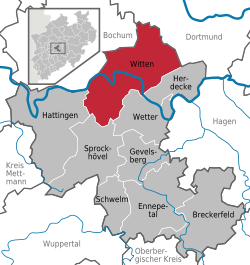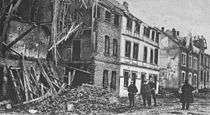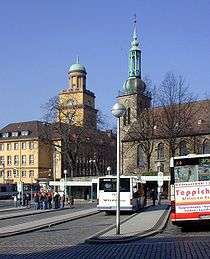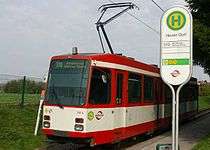Witten
| Witten | ||
|---|---|---|
|
Town hall in Witten | ||
| ||
 Witten | ||
Location of Witten within Ennepe-Ruhr-Kreis district  | ||
| Coordinates: 51°26′0″N 7°20′0″E / 51.43333°N 7.33333°ECoordinates: 51°26′0″N 7°20′0″E / 51.43333°N 7.33333°E | ||
| Country | Germany | |
| State | North Rhine-Westphalia | |
| Admin. region | Arnsberg | |
| District | Ennepe-Ruhr-Kreis | |
| Government | ||
| • Mayor | Sonja Leidemann (no party affiliation) | |
| Area | ||
| • Total | 72.40 km2 (27.95 sq mi) | |
| Population (2015-12-31)[1] | ||
| • Total | 96,700 | |
| • Density | 1,300/km2 (3,500/sq mi) | |
| Time zone | CET/CEST (UTC+1/+2) | |
| Postal codes | 58401 - 58456 | |
| Dialling codes |
02302 02324 (Buchholz) | |
| Vehicle registration | EN, WIT | |
| Website | witten.de | |
Witten is a university city in the Ennepe-Ruhr-Kreis (district) in North Rhine-Westphalia, Germany. It is the home of the Witten/Herdecke University, the first private university in Germany.
Geography
Witten is situated in the Ruhr valley, in the southern Ruhr area.
Bordering municipalities
Division of the town
Witten is divided into 8 boroughs and every of these boroughs is divided into city-districts. Every district has its own district-number:
- Witten-Mitte: 11 Innenstadt, 12 Oberdorf-Helenenberg, 13 Industriegebiet-West, 14 Krone, 15 Crengeldanz, 16 Hauptfriedhof, 17 Stadion, 18 Industriegebiet-Nord, 19 Hohenstein
- Düren: 21 Düren-Nord, 22 Düren-Sued
- Stockum: 31 Stockum-Mitte, 32 Dorney, 33 Stockumer Bruch, 34 Wilhelmshöhe
- Annen: 41 Tiefendorf, 42 Wullen, 43 Annen-Mitte-Nord, 44 Annen-Mitte-Süd, 45 Kohlensiepen, 46 Wartenberg, 47 Gedern
- Rüdinghausen: 51 Industriegebiet-Ost, 52 Rüdinghausen-Mitte, 53 Buchholz, 54 Schnee
- Bommern: 61 Steinhausen, 62 Bommerbank, 63 Bommerfeld, 64 Wettberg, 65 Buschey, 66 Bommeregge
- Heven: 71 Papenholz, 72 Hellweg, 73 Wannen, 74 Heven-Dorf, 75 Lake
- Herbede: 81 Herbede-Ort, 82 Vormholz, 83 Bommerholz-Muttental, 84 Durchholz, 85 Buchholz-Kaempen
Religions

Roman Catholic
When Witten was first mentioned in historical documents, it was part of the Archdiocese of Cologne. Since 1821 it has been a part of the Diocese of Paderborn; however, the borough of Herbede belongs to the Diocese of Essen. In the 19th century the Ruhr area drew up to 500,000 Poles from East Prussia and Silesia, most of whom were Catholic. Hundreds settled in Witten, leading to a growth in the Catholic community. Today, between 30 and 40 per cent of the population is Catholic.
Protestant
In the 16th century Witten was influenced by Martin Luther's Reformation, and until the late 19th century, Witten was a predominantly Protestant town with just a few Catholic inhabitants. Between 30 and 40 per cent of the population is Protestant today.
Muslims
There are four mosques in Witten, Annen and Herbede today, founded by immigrants from Turkey who arrived in the 1970s and 1980s. Between five and eight per cent of the population is Muslim.
Jews

In 1815 the first Jewish community was mentioned in Witten. In 1938 the synagogue was destroyed during the so-called "Reichspogromnacht" (also known as Kristallnacht) of 9–10 November 1938. Today, only about a dozen Jews live in Witten. They belong to the Jewish community in Dortmund.
Since 1994 the place of the former synagogue is marked with a memorial.
Population 1739–2005
|
|
|
History

Witten was first mentioned in historic sources in 1214, however the borough Herbede (which was incorporated into the city in 1975) dates back to 851. The city was a mining town from 1578. In 1946, it was included in North-Rhine Westphalia on its establishment. In 1975 Witten was included in the administrative district Ennepe-Ruhr-Kreis and it is now its biggest city. 1975 was also the year Witten was first counted to have more than 100,000 inhabitants, the threshold to be considered a large city ("Großstadt") in Germany.
Roburit Explosion
In the late 19th century Witten was known for the Roburit dynamite. This dynamite was once used by coal mines around the world. In 1906 an explosion occurred, resulting in the deaths of 41 people.
Politics

The Council of Witten
The local council of Witten has 64 seats. In the local elections of 2004 the German Social Democratic Party, SPD, gained 24 seats and form the largest party represented on the council. It is followed by the Christian Democratic Party, CDU with 18 and the Greens with 7 seats. They are followed by the WBG (a conservative list) with 4, FDP 4, FLW (also a conservative list) 3, NPD 2, PDS/WAL (socialists) 1 and AUF Witten (a left wing list) also 1. Since 2004 for the first time in its history the council is led by a female mayor: Sonja Leidemann, SPD.
Members of Parliament
Landtag
- 2005–today: Thomas Stotko, MdL (SPD)
German Bundestag
- 1998–today: Dr. Ralf Brauksiepe, MdB (CDU)
- 1998–today: Christel Humme, MdB (SPD)
- 2005–today: Irmingard Schewe-Gerigk, (B´ 90/Die Grünen)
- 2005–today: Konrad Schily, (FDP)
Transport

Witten is connected to the Autobahn network by the A 43 and A 44 motorways. It has a central station, connecting the city to the regional-train-network of Deutsche Bahn. Local service is carried out by the BOGESTRA, a joint venture between the cities of Bochum and Gelsenkirchen, to which most of the bus lines in Witten belong. There is a tram line connecting to Bochum. Public transport in the city is carried out according to the fare system of the VRR transport association.
Coat of arms
The coat of arms of Witten with its two lions once belong to the Everhards von Witten-Steinhausen and was first mentioned in 1283. The family of Witten-Steinhausen belongs to the founders of the town of Witten. Their slogan was: "Sigillum Hermanni de Wittene". Because of its long history this Coat of arms was the only one in the Ruhr area, that was not forbidden by the Allies in May 1945, after the End of the Second World War.
Culture
- Hebezeug-Museum – a museum dedicated to cranes and hoist founded by J. D. Neuhaus and is located on the Route der Industriekultur.
- Wittener Tage für neue Kammermusik, festival for contemporary chamber music, held annually at the end of April
Twin towns – sister cities
-
 Beauvais, France, since 1975[2]
Beauvais, France, since 1975[2] -
 London Borough of Barking and Dagenham, United Kingdom, since 1979[2]
London Borough of Barking and Dagenham, United Kingdom, since 1979[2] -
 Mallnitz, Carinthia, Austria, since 1979[2]
Mallnitz, Carinthia, Austria, since 1979[2] -
 Lev HaSharon district, Israel, since 1979[2]
Lev HaSharon district, Israel, since 1979[2] -
 Wolfen, Germany, since 1990[2]
Wolfen, Germany, since 1990[2] -
 Kursk, Russia, since 1990[2]
Kursk, Russia, since 1990[2] -
 Tczew, Poland, since 1990[2]
Tczew, Poland, since 1990[2] -
 San Carlos, Nicaragua (since 1990, friendship contract)
San Carlos, Nicaragua (since 1990, friendship contract) -
 Mek'ele, Ethiopia (since 2016)
Mek'ele, Ethiopia (since 2016)
References
- Notes
- ↑ "Amtliche Bevölkerungszahlen". Landesbetrieb Information und Technik NRW (in German). 18 July 2016.
- 1 2 3 4 5 6 7 8 "List of Twin Towns in the Ruhr District". Twins2010.com. Archived from the original (PDF) on November 28, 2009. Retrieved 2009-10-28. External link in
|publisher=(help)
| Wikimedia Commons has media related to Witten. |

